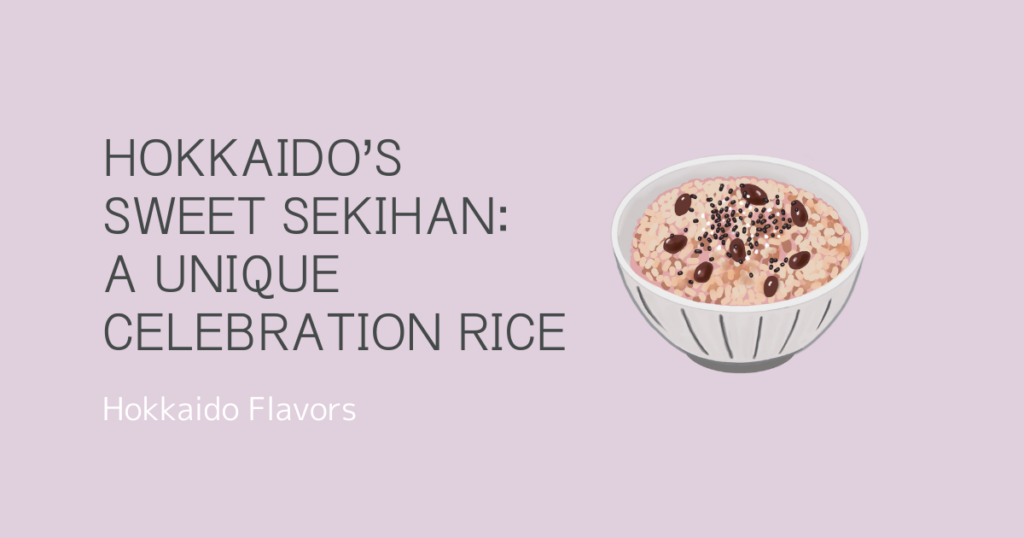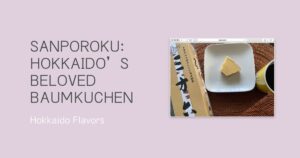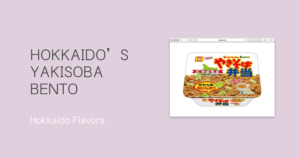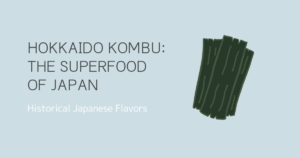Sekihan (赤飯) is a traditional Japanese dish served during special occasions. Typically made with glutinous rice and adzuki beans, sekihan’s red color symbolizes good fortune and protection against evil spirits. However, Hokkaido has its own unique version, which replaces adzuki beans with sweetened amanatto (candied beans).
For those unfamiliar with Hokkaido-style sekihan, the idea of using sweet beans in a savory dish might sound surprising. However, for locals, this version of sekihan is a nostalgic and beloved staple. This article explores the history, cultural significance, and recipe for Hokkaido’s sekihan, as well as where to find it in Hokkaido.
What Is Sekihan? A Traditional Japanese Celebration Dish
Sekihan is a dish made from glutinous rice and adzuki beans, often seasoned with a pinch of salt or sesame seeds. It is widely enjoyed across Japan during celebrations and ceremonies.
When Do Japanese People Eat Sekihan?
Sekihan is commonly served on special occasions, including:
- Baby celebrations (Oshichiya & Omiyamairi) – Families prepare sekihan to celebrate a baby’s birth and first shrine visit.
- Seasonal Festivals (Hinamatsuri & Children’s Day) – Often included in festive meals.
- School Entrance, Graduation & Coming-of-Age Ceremonies – A dish to mark new beginnings.
- Weddings & Longevity Celebrations – Served at wedding feasts and milestone birthdays such as 60 (Kanreki) and 88 (Beiju).
- Shinto Rituals & Temple Offerings – Frequently used in religious offerings and celebrations.
Image Placement: Traditional Japanese sekihan served in a lacquer bowl
(Alt text: A bowl of traditional Japanese sekihan with sesame seeds and salt.)
Regional Variations of Sekihan
Different regions in Japan have their own styles of sekihan:
- Kanto & Kansai: Uses adzuki beans or sasage beans, which maintain their shape during cooking.
- Tohoku & Hokuriku: Higher glutinous rice content for a chewy texture.
- Kyushu & Okinawa: Sometimes eaten with sugar instead of salt.
- Hokkaido: Uses sweet amanatto (candied beans) and is colored pink using food coloring.
What Makes Hokkaido’s Sekihan Unique?
Hokkaido’s sekihan differs significantly from the traditional version found in other parts of Japan. Instead of adzuki beans, it uses amanatto (candied red beans or green peas), and the rice is dyed pink using food coloring.
Why Does Hokkaido Use Amanatto in Sekihan?
Several factors contributed to the development of this unique style:
- Ease of Preparation – Traditional sekihan requires careful cooking of adzuki beans, while amanatto is pre-cooked and preserved, making it much easier to use.
- Hokkaido’s Thriving Bean Industry – As Japan’s largest producer of red beans, Hokkaido naturally incorporated locally grown legumes into its cuisine.
- Post-War Food Culture – After World War II, sweet flavors became popular in Hokkaido, and the use of amanatto in sekihan spread widely.
How Does Hokkaido Sekihan Taste?
Hokkaido-style sekihan has a subtle sweetness from the candied beans, combined with a chewy texture from the glutinous rice. The dish is typically sprinkled with salt before serving, creating an enjoyable balance of sweet and savory flavors.
Image Placement: Close-up of Hokkaido-style sekihan with amanatto beans
(Alt text: Hokkaido-style sekihan with pink rice and sweet amanatto beans.)
How to Make Hokkaido-Style Sekihan (Recipe)
Ingredients (Serves 4)
- 2 cups glutinous rice
- 100g (3.5 oz) sweet amanatto (adzuki or green pea variety)
- 1.5 cups water
- A pinch of red food coloring (optional)
- Salt to taste
Instructions
- Wash and soak the glutinous rice for 30 minutes.
- Drain the rice and place it in a rice cooker or steamer. Add 1.5 cups of water and a small amount of food coloring.
- Cook the rice as usual (either in a rice cooker or by steaming for about 30–40 minutes).
- Once cooked, gently mix in the sweet amanatto.
- Let it steam for 10 minutes, then serve with a sprinkle of salt.
📢 Tip: Unlike traditional sekihan, Hokkaido sekihan is best enjoyed with a touch of salt rather than sesame seeds.
Image Placement: Step-by-step sekihan preparation process
(Alt text: Step-by-step images of cooking Hokkaido-style sekihan, from rice soaking to mixing in amanatto.)
Where to Buy Hokkaido Sekihan?
Hokkaido sekihan is widely available in:
- Supermarkets – Commonly found in the bento section.
- Convenience Stores – Some chains offer sekihan onigiri.
- Traditional Japanese Restaurants – Served as part of set meals.
If you are visiting Hokkaido, check the bento section of local supermarkets or convenience stores for a taste of this regional specialty.
Image Placement: Packaged Hokkaido sekihan from a supermarket
(Alt text: Pre-packaged Hokkaido sekihan sold in a Japanese supermarket.)
Conclusion: Try Hokkaido’s Unique Sweet Sekihan!
While traditional sekihan is a savory dish, Hokkaido’s version offers a fascinating balance of sweetness and saltiness. It is a staple in Hokkaido homes, and many who try it for the first time find themselves pleasantly surprised.
If you are a fan of Japanese food and looking for a unique dish, Hokkaido sekihan is a must-try!
📌 Have you ever tried Hokkaido’s sweet sekihan? Let us know in the comments!



